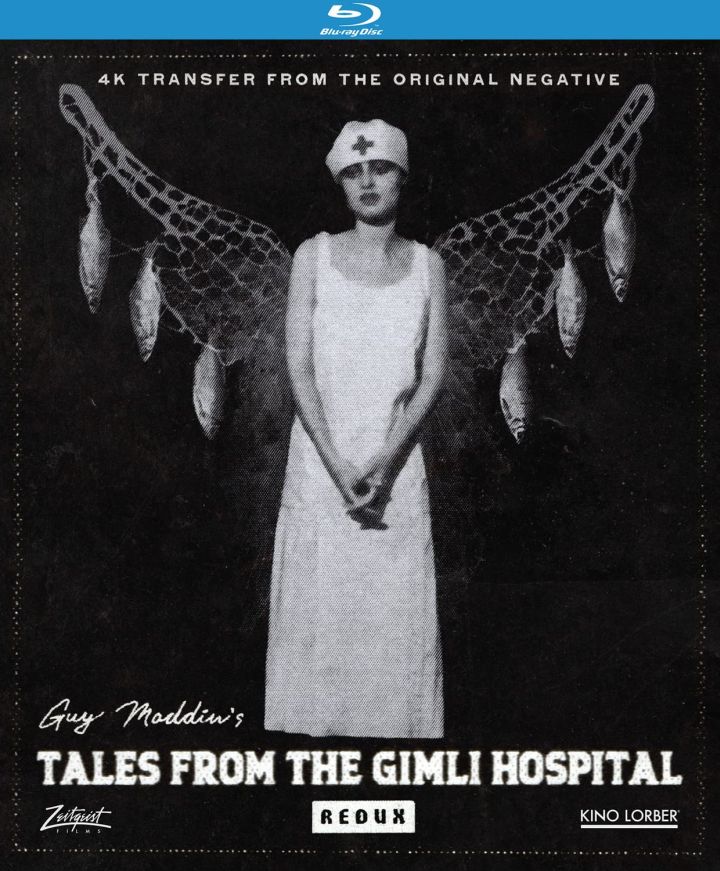
David Cronenberg, fellow Canadian and not a stranger to weirdness once said, “You haven’t truly seen a foreign film until you’ve seen a Guy Maddin film.” Coming from a weirdo of Cronenberg’s caliber, that should mean something. And Tales from the Gimli Hospital, Maddin’s first feature length film, feels very foreign indeed.
It is idiosyncratic in every way that it is possible to be. Made in 1988, the film is shot mostly to look like a silent film… except it has sound and dialogue. Except when it doesn’t. Sometimes there’s narration, but the narration fades out and we’re confronted with bizarre imagery that does not explain itself. It’s an art film, there’s no question about that.
But the notion of an “art film” can carry some negative expectations that Gimli Hospital happily does not fulfill. First, art films are supposed to be self-serious. Gimli Hospital is, at least occasionally, funny. And it has a narrative, that gets fulfilled. It doesn’t deliberately undermine audience enjoyment for the sake of making an artistic point. It’s just really weird.
We start in a hospital. Wait, no, we start moving through the heavens, complete with angels, before we get to a hospital room, where a pair of children are with their ailing mother. An old woman wants to comfort them, so she tells them a completely terrifying story of the hospital from years before.
It’s about the origins of Gimli Hospital, and of the Icelandic natives who live on this specific spot in Winnipeg. It would be hard to go into specifics without just detailing each bizarre scene, shot by shot, but apparently the women like to frolic by the beach in party dresses while the men rub their faces with straw and squeeze fish oil into their hair. They also wrestle with each other by huddling face to face and grabbing the seat of each other’s pants.
Our protagonist, Einar the Lonely, gets his eye on a girl, but then he comes down with a disease. The entire community is getting sick. The back of the Blu-ray case says it’s smallpox, but the movie never makes that clear.
Einar goes to the hospital (which has the constant sound of barnyard animal noises) and befriends the patient in the next bed, Gunnar. He has the hobby of cutting fish shapes out of pieces of bark. They bond over this distraction, until Gunnar borrows Einar’s shears. They were identical to those he left on his dead wife’s cairn.
Einar admits he found the cairn, stole the shears, and worse violated the fresh corpse of the woman there. This, predictably, is not good for the men’s friendship. Gunnar strikes out against Einar, who runs away. There’s a confrontation… and then everything ends up all right.
Describing the story of this film seems largely beside the point, because it is entirely about the experience of watching it. It presents a cascade of odd images and themes that do not assert themselves so much as hint at their existence.
For instance, there’s a sexual aspect to the nurses at Gimli hospital that is largely sublimated, but present. They are always in clingy one-piece smocks and braless. Gunnar tells them stories and gets their attention, which Einar fails to emulate. At night, they put up sheet barriers between the patients, and Einar lustfully watches their silhouettes as they do… something with Gunnar, which is never completely clear.
Maddin takes his cues from several different styles of filmmaking. Gimli Hospital mostly looks like a silent film, though it has dialogue. Sometimes that dialogue is in English, sometimes it isn’t. It also has scenes that look like they could be from a low budget Busby Berkeley musical, and sometimes from German Expressionist horror. The look is so individual and intentionally handcrafted that the film was rejected by the Toronto International Film Fest for being amateurish.
Tales from the Gimli Hospital Redux is a weird film. The “Redux” is because the film has been remastered and restored, with the replacement of a “long-lost” scene. The scene, which is an insert of a fantasy or dream Einar has in the hospital, was actually shot a decade after the film had been completed. It’s just as idiosyncratic as everything that came before and falls completely in place.
The idiosyncrasies are bizarre. In the framing story, the sick mother for some reason has a Big Gulp cup on her bed. In the Gimli hospital, they put out a fire on the ceiling by pouring milk on it, which then spills down on poor Gunnar. At one time, sleepwalking, Einar eats a nurse’s hat. It would be exasperating if the film had the sense of pretense that one often feels with artistic or experimental film. As weird as Tales from the Gimli Hospital got, I never felt talked down to. I wasn’t being taught a lesson. I was watching a weird movie.
But a weird movie with a story and its own sensibility. Tales from the Gimli Hospital is short, barely more than an hour, and were it to go on much longer the sense of watching a dream might have felt more like a nightmare. As it stands, it’s a brief trip into a very strange place. I’m glad I visited, though I think I’m happy I don’t have to live there.
Tales from the Gimli Hospital Redux has been released on Blu-ray by Kino Lorber and Zeitgeist Films. Extras on the disc include a commentary track by director Guy Maddin; his short film, Heart of the World; and a trailer.